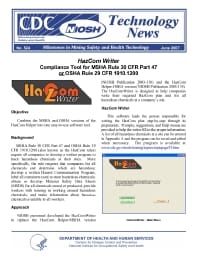Mining Publication: Technology News 524 - HazComWriter Compliance Tool for MSHA Rule 30 CFR Part 47 or OSHA Rule 29 CFR 1910.1200
Original creation date: June 2007
Authors: DF Scott
NIOSHTIC2 Number: 20032099
Spokane, WA: U.S. Department of Health and Human Services, Public Health Service, Centers for Disease Control and Prevention, National Institute for Occupational Safety and Health, DHHS (NIOSH) Publication No. 2007-144, Technology News 524, 2007 Jun; :1-2
Objective: Combine the MSHA and OSHA versions of the HazCom Helper into one easy-to-use software tool. Background: MSHA Rule 30 CFR Part 47 and OSHA Rule 29 CFR 1910.1200 (also known as the HazCom rules) require all companies to develop a written program to track hazardous chemicals at their sites. More specifically, the rule requires that companies list all chemicals and determine which are hazardous; develop a written Hazard Communication Program; label all containers used to store hazardous chemicals; obtain or develop Material Safety Data Sheets (MSDS) for all chemicals stored or produced; provide workers with training in working around hazardous chemicals; and make information about hazardous chemicals available to all workers. Approach: NIOSH personnel developed the HazComWriter to replace the HazCom Helper-MSHA version (NIOSH Publication 2003-118) and the HazCom Helper-OSHA version (NIOSH Publication 2005-135). The HazComWriter is designed to help companies write their required HazCom plan and list all hazardous chemicals at a company's site. HazComWriter: This software leads the person responsible for writing the HazCom plan step-by-step through its preparation. Prompts, suggestions, and Help menus are provided to help the writer fill in the proper information. A list of all hazardous chemicals at a site can be entered in Appendix A and the program can be saved and edited when necessary. The program is available at: http://www.cdc.gov/niosh/mining/topics/chemicalhazards.

NIOSHTIC2 Number: 20032099
Spokane, WA: U.S. Department of Health and Human Services, Public Health Service, Centers for Disease Control and Prevention, National Institute for Occupational Safety and Health, DHHS (NIOSH) Publication No. 2007-144, Technology News 524, 2007 Jun; :1-2